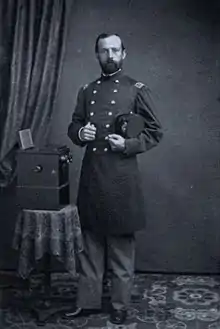William Crooks (colonel)
William "Billy" Crooks (June 20, 1832 – December 17, 1907)[1] was a Colonel during the American Civil War, member of the House of Representatives, U.S. Military Academy graduate, and a veteran railroader. He led the 6th Regiment Minnesota Volunteer Infantry from August 1862 to October 1864, mainly contending against the Sioux. Crooks built the first rail line in the State of Minnesota, the St. Paul & Pacific. His first locomotive he named for himself the William Crooks'a 4-4-0 and began its operation in 1861. His operation was taken over by James J. Hill. The William Crooks would become the first locomotive of Hill's Great Northern Railroad.
Colonel William Crooks | |
|---|---|
 | |
| Born | June 20, 1832 New York City, New York[1] |
| Died | December 17, 1907 (aged 75) Portland, Oregon[1] |
| Buried | Oakland Cemetery, Saint Paul, MN[1] |
| Allegiance | Union |
| Years of service | August 1862 - October 1864[1] |
| Rank | |
| Commands held | 6th Minnesota Infantry |
| Battles/wars | Battle of Birch Coulee |
| Spouse(s) | Arabella Crooks, Harriet Marie Crooks |
| Children | 4 |
| Member of the Minnesota Senate from the 23rd district | |
| In office January 4, 1881 – January 1, 1883 | |
| Preceded by | John H. Reaney |
| Member of the Minnesota House of Representatives from the 23rd district | |
| In office January 5, 1875 – January 7, 1878 | |
| Preceded by | Henry Meyerding |
| Succeeded by | John H. Reaney |
| Personal details | |
| Residence | Saint Paul, Minnesota |
Early life and career
When William Crooks was seventeen, he enrolled at West Point and graduated in the department of Civil Engineers.[2] (class of 1854). In 1852, William Crooks began his career as an engineer with Morris & Essex Road.[3] From 1853 to 1855 he was assistant engineer for the Michigan Southern & Northern Indiana, and shortly after he occupied a similar position with the New York State Canal[3] from 1855 to 1857. At the same time from 1859 to 1862, Crooks was also chief engineer at St. Paul & Pacific Railroad.[3] Crooks then served the following two years as assistant engineer for the Minnesota & Pacific Railroad.[3] Over the next 38 years, Crooks came to Portland as assistant to A. L. Mohler, general manager of the O.R. & N[3] and was associated with other railroads in various capacities. From 1862 to 1865, he was Colonel of the 6th Minnesota regiment[4][5][6] with the Union Army. In 1869 Crooks engaged in railroad contract work until 1890.[7] The following two years until 1892 he was president and chief engineer of Wadena & Park Rapids Railroad.[3] His final job was chief engineer at Minneapolis & St. Louis Railroad that lasted three years until 1895.[3] During is life, Colonel Crooks was recognized as one of the best railroaders in the country[3]
Civil War
William Crooks served as Colonel in the 6th Minnesota Volunteer Infantry Regiment[4][5][6] and lead five companies that fought against the Indians in the U.S.-Dakota War.[5] Formed in Hokah, MN,[8] the 6th Regiment was organized throughout the summer and fall of 1862 in response to President Abraham Lincoln's calls for a total of 600,000 additional troops. Over the course of the next two years, the regiment stayed in Minnesota due to the outbreak of the 1862 Dakota War despite the original plan to head south.[5] Colonel Crooks was also president of a court-martial by which 100 Native American were condemned to death. His task was to bring about a revision of the findings of the bodies so that not more than 40 of the convicted Indians were executed.[3][9] By the spring of 1864, the members of the Sixth Regiment were directed to carry on to Helena, Arkansas, on the Mississippi River. The Sixth Regiment, 950 total, arrived in Helena on June 23, 1864, and spent the next four months in unpredictable conditions. By this time, 58 enlisted men had died from malaria and over 650 people reported as sick. Finally in November, Colonel Crooks' troops were sent to fight under command of General E.R.S. Canby's campaign in Mobile, Alabama, and were in reserve during the April 9 capture of Fort Blakely. On August 19, 1865, William Crooks and his regiment returned home at last to Fort Snelling after a successful battle with the South.[5]
Death
For years of suffering from a kidney disease, William Crooks' condition became consistently worse until late 1907, when he contracted a severe cold. Many telegrams from prominent railroad officials throughout the country expressed sympathy for Crooks' family when he died at the age of 75 in Portland, Oregon. Crooks' funeral services were held in St. Paul days after his death, and his body was accompanied by his son and family. Colonel Crooks' engines used by the Northern Pacific Railway Company are still preserved in the car shops of the Hill system at St. Paul as a relic of the early railroad history of the country.[3]
References
- "Crooks, William "Wm."". Minnesota Legislative Reference Library. Retrieved June 29, 2020.
- "20 Apr 1939, 9 - The Evening News at Newspapers.com". Newspapers.com. Retrieved June 28, 2020.
- "Col. William Crooks - Oregon Pioneer Obituaries". sites.google.com. Retrieved June 28, 2020.
- "Renville County, Minnesota - Sioux Uprising, Birch Coulee". genealogytrails.com. Retrieved June 28, 2020.
- "Sixth Minnesota Volunteer Infantry Regiment | MNopedia". www.mnopedia.org. Retrieved June 28, 2020.
- "Colonel William Crooks 1894". The Princeton Union. September 13, 1894. p. 3. Retrieved June 28, 2020.
- "Col. William Crooks - Oregon Pioneer Obituaries". sites.google.com. Retrieved June 29, 2020.
- "U.S. Dakota War 1862 Minnesota County by County" (PDF). U.S. Dakota War 1862 Minnesota County by County.
- "Newspapers.com Viewer". Newspapers.com. Retrieved June 29, 2020.